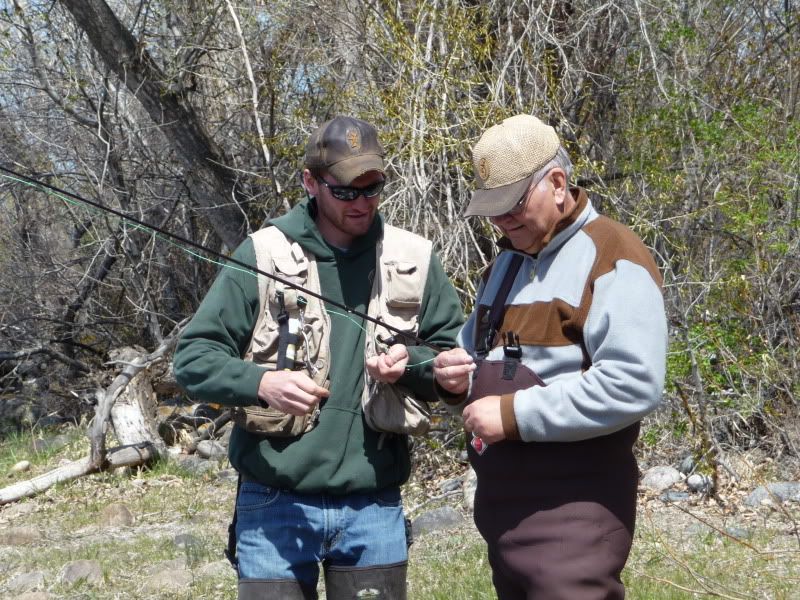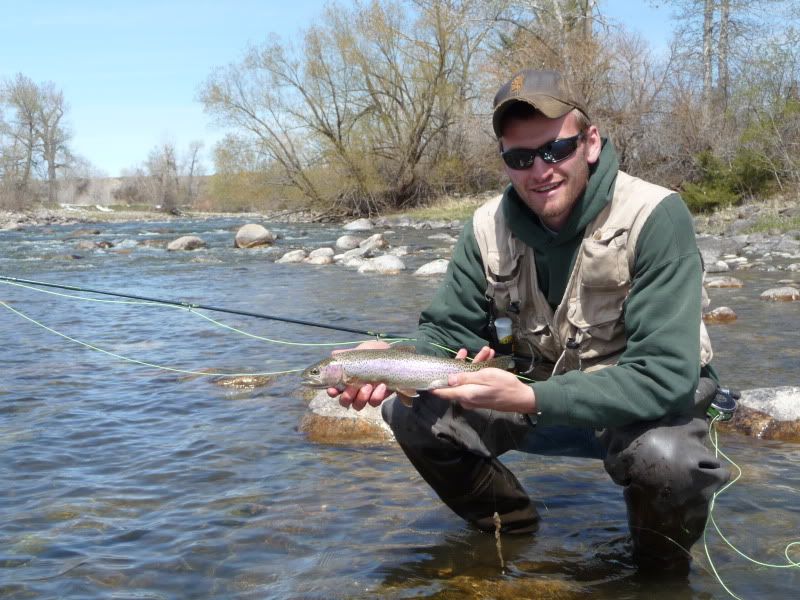Every spring, beginning in early May and peaking around Mother’s Day weekend, our area rivers experience an explosion of caddis flies, and a subsequent explosion of active, feeding, and often easy-to-catch trout. The trick of the whole thing, like any other fishing situation, is to hit the river at just the right time. This year, with my fiance’s family (and two fellow anglers) visiting for the weekend, we hit the hatch spot on.
Long before they showed up for Mother’s Day weekend, it had been decided. Actually, it was pretty much a given. The girls would go shopping at a nearby touristy-type town, while the guys would go fishing.
Everyone was up early Saturday. That’s not usually in the plans when I’m fishing out here. Growing up back East, the fishing was best at dawn and dusk, but trout fishing in most western trout rivers is different. The water running off the mountains that feeds these streams is icy cold, and requires some warming during the day to get the trout going. So we lounged around a bit in the morning. Paul and Matt still had to get together their gear and rig up rods, and I had a few last minute flies to tie. Then it was off to a late breakfast at the local restaurant, and finally a half dozen miles of smooth sailing over freshly graded gravel roads to the river.
It wasn’t much before 11 am when we were parked and getting into waders. The river looked good. The water was low and clear, the air was calm and the skies were fair. All we needed was a hatch to get the trout going. As we stood by the river bank choosing and tying on flies, I heard a splash. Rings formed at the surface of the pool just upstream from the bridge, one of the first rises of the day. I selected a couple of flies for Paul as a caddis adult started flying around my face. The hatch was going to be good. A couple splashes later, we were frantically trying to get our gear fishing as quick as possible.

The rises came more frequently as we spread out along the river and started fishing. I started with one of the many different dry caddis imitations I had with me. Paul was fishing the slow run below the pool just up from the bridge, Matt was fishing an upstream run, and I was fishing between the two of them. The hatch was still a bit slow, but started picking up. I heard a splash and looked upstream. Matt had a fish on. A fiesty little brown had taken a small caddis imitation he’d picked out of my fly box.

Not long after, I had a rainbow on. The post-spawned female had come up from the big river to lay eggs, and was feeding on her way back home.

Soon enough it started to get crazy. The caddisflies started hatching everywhere we looked and the fish went absolutely nuts. Fish distributed throughout the river, in slow water and fast, and started jumping everywhere. Bodies started clearing the water everywhere. The fishing was hot for a while, but it quickly became tougher. After an hour or two, my attempts to get the fish to take my fly among the swarm of naturals were getting more and more futile. Then the hatch stopped. Everything stopped. No more caddis coming off the water, and no more fish rising. The frenzy had lasted for a couple of hours, gave the fish their fill and stopped just as abruptly as it had started.
As we walked back to the truck I had a sudden idea. The hatch was undoubtedly finished where we were, but several miles upstream, where the water was cooler and flowed through a more shaded area, perhaps the hatch was still going, or even just starting.
We kept our gear together and took a ride up to the bridge crossing I had in mind. I saw a rise at a big pool upstream in the distance. After a short wade upstream, we spread out again and started fishing. Sure enough, the hatch was just starting here and we were poised to hit it just right.
Again, the fish went nuts, and we were in just the right location to get them. Eventually, Matt and Paul ended up fishing the huge pool where I’d first seen a rise, and I was maybe a hundred yards upstream from them. By now I’d keyed in on the fly that seemed to work best at imitating the naturals, and started hammering them. I think they would have taken just about anything in the box that looked remotely like a caddis, but the size 16 peacock herl with a tan wing was getting fish on nearly every cast. I caught my first eight fish without moving a single step. They were nice rainbows and browns, ranging in length between 12 and 15 inches.
It seemed like every time I looked downstream to see how the other fellas were doing, one of them had a fish on. You know how you look around sometimes when you have a nice fish on and wonder if anyone else notices? Matt and I found ourselves doing that a few times while both of us were hooked up to good fighters.
This hatch, too, came to an end, but it was about time to head home anyway. With good dinner and conversation to look forward to, we’d gathered enough fishing memories to last for at least another day.


Leave a Reply